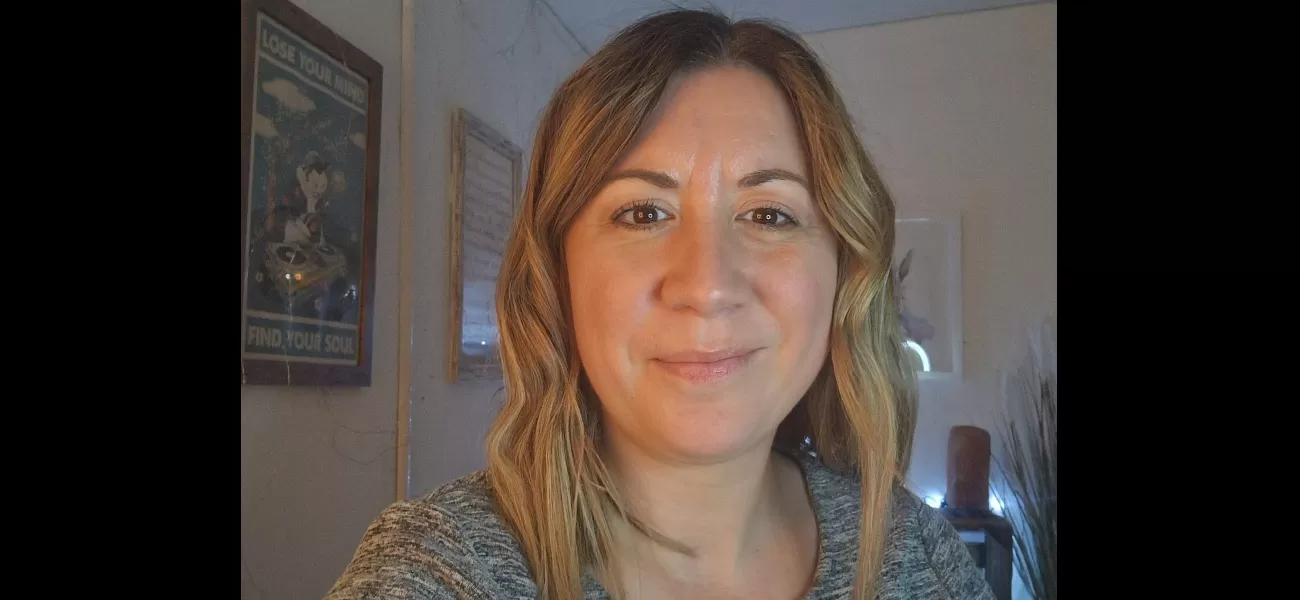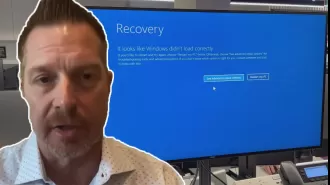My doctor didn't grasp my symptoms until I provided my own research.
Functioning normally was nearly impossible for me.
May 19th 2024.

As I sat on the pebbles, watching the sun dip below the horizon, I couldn't help but let out a sigh of relief. For the first time in what felt like forever, I felt truly relaxed. My mind was quiet, my shoulders were relaxed, and I wasn't clenching my jaw anymore. This was a rare occurrence for me, as someone who had been diagnosed with premenstrual dysphoric disorder (PMDD). It was something that only happened for a couple of weeks out of every month, but ever since my partner and I had moved away from the hustle and bustle of city life to the peaceful south coast, it was slowly becoming my new normal.
After more than two decades of agonizing periods, severe anxiety, mood swings, and other debilitating symptoms, I had finally found some peace amidst the chaos of my menstrual cycle. I couldn't believe how good it felt to finally feel like myself again. Since I was a teenager, my periods had been almost unbearable, but back then, in the 90s, women were just expected to tough it out. None of my friends seemed to have the same issues as me, and I struggled to cope with the excruciating cramps and intense emotional symptoms.
Even when I went on birth control as a teenager, it made no difference to my symptoms. In my mid-twenties, I tried a contraceptive injection, but instead of helping, it only made things worse. My symptoms became more severe and debilitating, leading to bouts of rage, anxiety, and paranoia. By 2008, everything came crashing down, and I could no longer function normally. I struggled with fatigue, anxiety, and difficulty concentrating, which made it hard to keep up with my job as a lettings agent. Eventually, I also began to suffer from depression, and I couldn't even go to the supermarket without my partner by my side.
As a result, I had to reduce my working hours, and my overall quality of life suffered. I couldn't imagine living like this forever, so I refused to accept it as my future. Over the years, I went to countless medical appointments and underwent numerous tests, only to be misdiagnosed with ME and nearly bipolar disorder. It wasn't until a friend mentioned a condition called PMDD in 2018 that everything finally made sense. After tracking my symptoms and menstrual cycle for three months, I took the information to my doctor, who quickly confirmed my suspicions.
I was officially diagnosed with PMDD, a hormone-based mood disorder that affects 5.5% of women and assigned female at birth of reproductive age. Sadly, it takes an average of 12 years to receive a formal diagnosis, and there is no specific medication or cure for PMDD. The only treatments offered on the NHS are SSRIs, birth control, HRT, chemical menopause, and a full hysterectomy, which involves removing the ovaries to stop the cycle. Other forms of treatment, such as therapy and pain management, are also recommended but not readily available on the NHS.
Determined to take control of my symptoms, I delved into research and found various ways to manage them. I spent hours reading forums and blog posts, and I eventually came across suggestions for lifestyle changes and holistic therapies. At first, I made the mistake of trying to implement all these changes at once, which quickly became overwhelming. I couldn't tell what was working and what wasn't, so I learned to take things one step at a time.
The first thing I changed was my diet. I cut down on caffeine and only drank alcohol at certain times of the month to avoid triggering my symptoms. I also trained in clinical hypnotherapy and made it a habit to regularly stroll along the beach, which helped me relax and manage my anxiety. My partner and I also decided to move from South London to the Sussex coast, and that was when I saw the biggest change in my symptoms. The slower pace of life and the soothing surroundings had a tremendous impact on my well-being. I still have my struggles, but I've found ways to manage my symptoms and live a fulfilling life.
As I sat on the damp pebbles, gazing at the sun setting over the horizon, a sense of relief washed over me. For the first time in what felt like forever, I felt truly at ease. My mind quieted, my tense shoulders relaxed, and my jaw unclenched. It was a rare occurrence for someone like me, who struggles with premenstrual dysphoric disorder, to feel this way. But ever since my partner and I moved away from the fast-paced city life to the slower pace of the south coast, it was becoming my new normal.
After over two decades of enduring heavy and debilitating periods, along with a laundry list of other symptoms such as severe anxiety, rage, dysphoria, hopelessness, and suicidal thoughts, I had finally found some peace amidst the chaos of my menstrual cycle. It was almost unbelievable how good I felt. As a teenager, my periods were almost unbearable, but back then, it was a different time. Women were expected to just grin and bear it, as if period problems were just a part of being a girl going through puberty. None of my friends seemed to experience the same struggles.
My cramps were excruciating, often leading me to physically pull my hair out in an attempt to distract myself from the pain. And it wasn't just physical symptoms that plagued me. I also suffered from a range of mental and emotional symptoms, such as fatigue, anxiety, and executive dysfunction, making it difficult to focus in school. Unfortunately, my teachers simply assumed I was lazy or had stayed up too late the night before. Even when I tried the pill and a contraceptive injection in my late teens and mid-twenties, respectively, my symptoms only worsened.
In 2008, everything came crashing down. I found it nearly impossible to function normally. I struggled with painful earaches, dizziness, and severe fatigue, making it challenging to concentrate at my job as a lettings agent. On top of that, I also experienced depression, anxiety, and suicidal thoughts. Even going to the supermarket alone was a daunting task. And, of course, all these symptoms became even more difficult to manage when I could no longer work full-time.
I refused to accept this as my future. For years, I went in and out of medical appointments, undergoing a barrage of tests and being misdiagnosed with ME and nearly bipolar disorder. Then, in 2018, a friend mentioned a condition she had called PMDD, and it all clicked. That's what I had been experiencing. After tracking my cycle and symptoms for three months and presenting the information to my GP, she finally diagnosed me with PMDD.
PMDD is a hormone-based mood disorder that is caused by an abnormal brain reaction to normal changes in the menstrual cycle. It's often confused with a hormone imbalance, but it's actually a severe form of premenstrual syndrome. It's estimated that 5.5% of women and assigned female at birth of reproductive age suffer from PMDD, but sadly, it takes an average of 12 years to receive a formal diagnosis. Currently, there is no cure or specific medication for PMDD, and the only treatments offered on the NHS are SSRIs, birth control, HRT, chemical menopause, and a full hysterectomy. Other forms of therapy and pain management are also recommended, but they can be difficult to access through the NHS.
Armed with this knowledge, I delved into researching ways to manage my symptoms. I spent countless hours scouring forums and blog posts, and I came across suggestions ranging from lifestyle changes to holistic therapies. At first, I made the mistake of trying to implement all these changes at once. I cut out alcohol, caffeine, and tried various supplements. But it quickly became overwhelming, and I couldn't tell what was actually helping. Eventually, I learned to take things one step at a time, making it more sustainable in the long run.
The first change I made was to my diet. I cut down on caffeine and only allowed myself to drink alcohol at certain times of the month to avoid triggering my symptoms. My partner and I also made the decision to move from South London to the Sussex coast, and I noticed a significant improvement in my symptoms. I also began training in Clinical Hypnotherapy, which has been incredibly beneficial in managing my PMDD.
Though there is no easy fix for PMDD, I've learned to manage my symptoms through a combination of lifestyle changes, therapy, and self-care. And while it's been a challenging journey, I am grateful to have finally found some peace amidst the chaos of my menstrual cycle.
After more than two decades of agonizing periods, severe anxiety, mood swings, and other debilitating symptoms, I had finally found some peace amidst the chaos of my menstrual cycle. I couldn't believe how good it felt to finally feel like myself again. Since I was a teenager, my periods had been almost unbearable, but back then, in the 90s, women were just expected to tough it out. None of my friends seemed to have the same issues as me, and I struggled to cope with the excruciating cramps and intense emotional symptoms.
Even when I went on birth control as a teenager, it made no difference to my symptoms. In my mid-twenties, I tried a contraceptive injection, but instead of helping, it only made things worse. My symptoms became more severe and debilitating, leading to bouts of rage, anxiety, and paranoia. By 2008, everything came crashing down, and I could no longer function normally. I struggled with fatigue, anxiety, and difficulty concentrating, which made it hard to keep up with my job as a lettings agent. Eventually, I also began to suffer from depression, and I couldn't even go to the supermarket without my partner by my side.
As a result, I had to reduce my working hours, and my overall quality of life suffered. I couldn't imagine living like this forever, so I refused to accept it as my future. Over the years, I went to countless medical appointments and underwent numerous tests, only to be misdiagnosed with ME and nearly bipolar disorder. It wasn't until a friend mentioned a condition called PMDD in 2018 that everything finally made sense. After tracking my symptoms and menstrual cycle for three months, I took the information to my doctor, who quickly confirmed my suspicions.
I was officially diagnosed with PMDD, a hormone-based mood disorder that affects 5.5% of women and assigned female at birth of reproductive age. Sadly, it takes an average of 12 years to receive a formal diagnosis, and there is no specific medication or cure for PMDD. The only treatments offered on the NHS are SSRIs, birth control, HRT, chemical menopause, and a full hysterectomy, which involves removing the ovaries to stop the cycle. Other forms of treatment, such as therapy and pain management, are also recommended but not readily available on the NHS.
Determined to take control of my symptoms, I delved into research and found various ways to manage them. I spent hours reading forums and blog posts, and I eventually came across suggestions for lifestyle changes and holistic therapies. At first, I made the mistake of trying to implement all these changes at once, which quickly became overwhelming. I couldn't tell what was working and what wasn't, so I learned to take things one step at a time.
The first thing I changed was my diet. I cut down on caffeine and only drank alcohol at certain times of the month to avoid triggering my symptoms. I also trained in clinical hypnotherapy and made it a habit to regularly stroll along the beach, which helped me relax and manage my anxiety. My partner and I also decided to move from South London to the Sussex coast, and that was when I saw the biggest change in my symptoms. The slower pace of life and the soothing surroundings had a tremendous impact on my well-being. I still have my struggles, but I've found ways to manage my symptoms and live a fulfilling life.
As I sat on the damp pebbles, gazing at the sun setting over the horizon, a sense of relief washed over me. For the first time in what felt like forever, I felt truly at ease. My mind quieted, my tense shoulders relaxed, and my jaw unclenched. It was a rare occurrence for someone like me, who struggles with premenstrual dysphoric disorder, to feel this way. But ever since my partner and I moved away from the fast-paced city life to the slower pace of the south coast, it was becoming my new normal.
After over two decades of enduring heavy and debilitating periods, along with a laundry list of other symptoms such as severe anxiety, rage, dysphoria, hopelessness, and suicidal thoughts, I had finally found some peace amidst the chaos of my menstrual cycle. It was almost unbelievable how good I felt. As a teenager, my periods were almost unbearable, but back then, it was a different time. Women were expected to just grin and bear it, as if period problems were just a part of being a girl going through puberty. None of my friends seemed to experience the same struggles.
My cramps were excruciating, often leading me to physically pull my hair out in an attempt to distract myself from the pain. And it wasn't just physical symptoms that plagued me. I also suffered from a range of mental and emotional symptoms, such as fatigue, anxiety, and executive dysfunction, making it difficult to focus in school. Unfortunately, my teachers simply assumed I was lazy or had stayed up too late the night before. Even when I tried the pill and a contraceptive injection in my late teens and mid-twenties, respectively, my symptoms only worsened.
In 2008, everything came crashing down. I found it nearly impossible to function normally. I struggled with painful earaches, dizziness, and severe fatigue, making it challenging to concentrate at my job as a lettings agent. On top of that, I also experienced depression, anxiety, and suicidal thoughts. Even going to the supermarket alone was a daunting task. And, of course, all these symptoms became even more difficult to manage when I could no longer work full-time.
I refused to accept this as my future. For years, I went in and out of medical appointments, undergoing a barrage of tests and being misdiagnosed with ME and nearly bipolar disorder. Then, in 2018, a friend mentioned a condition she had called PMDD, and it all clicked. That's what I had been experiencing. After tracking my cycle and symptoms for three months and presenting the information to my GP, she finally diagnosed me with PMDD.
PMDD is a hormone-based mood disorder that is caused by an abnormal brain reaction to normal changes in the menstrual cycle. It's often confused with a hormone imbalance, but it's actually a severe form of premenstrual syndrome. It's estimated that 5.5% of women and assigned female at birth of reproductive age suffer from PMDD, but sadly, it takes an average of 12 years to receive a formal diagnosis. Currently, there is no cure or specific medication for PMDD, and the only treatments offered on the NHS are SSRIs, birth control, HRT, chemical menopause, and a full hysterectomy. Other forms of therapy and pain management are also recommended, but they can be difficult to access through the NHS.
Armed with this knowledge, I delved into researching ways to manage my symptoms. I spent countless hours scouring forums and blog posts, and I came across suggestions ranging from lifestyle changes to holistic therapies. At first, I made the mistake of trying to implement all these changes at once. I cut out alcohol, caffeine, and tried various supplements. But it quickly became overwhelming, and I couldn't tell what was actually helping. Eventually, I learned to take things one step at a time, making it more sustainable in the long run.
The first change I made was to my diet. I cut down on caffeine and only allowed myself to drink alcohol at certain times of the month to avoid triggering my symptoms. My partner and I also made the decision to move from South London to the Sussex coast, and I noticed a significant improvement in my symptoms. I also began training in Clinical Hypnotherapy, which has been incredibly beneficial in managing my PMDD.
Though there is no easy fix for PMDD, I've learned to manage my symptoms through a combination of lifestyle changes, therapy, and self-care. And while it's been a challenging journey, I am grateful to have finally found some peace amidst the chaos of my menstrual cycle.
[This article has been trending online recently and has been generated with AI. Your feed is customized.]
[Generative AI is experimental.]
0
0
Submit Comment





